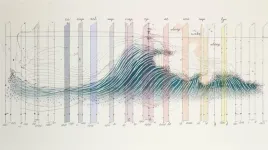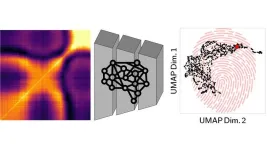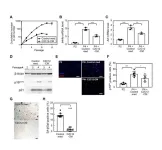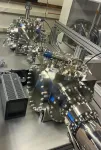(Press-News.org) Sleep and wake: they’re totally distinct states of being that define the boundaries of our daily lives. For years, scientists have measured the difference between these instinctual brain processes by observing brain waves, with sleep characteristically defined by slow, long-lasting waves measured in tenths of seconds that travel across the whole organ.
For the first time, scientists have found that sleep can be detected by patterns of neuronal activity just milliseconds long, 1000 times shorter than a second, revealing a new way to study and understand the basic brain wave patterns that govern consciousness. They also show that small regions of the brain can momentarily “flicker” awake while the rest of the brain remains asleep, and vice versa from wake to sleep.
These findings, described in a new study published in the journal Nature Neuroscience, are from a collaboration between the laboratories of Assistant Professor of Biology Keith Hengen at Washington University in St. Louis and Distinguished Professor of Biomolecular Engineering David Haussler at UC Santa Cruz. The research was carried out by Ph.D. students David Parks (UCSC) and Aidan Schneider (WashU).
Over four years of work, Parks and Schneider trained a neural network to study the patterns within massive amounts of brain wave data, uncovering patterns that occur at extremely high frequencies that have never been described before and challenge foundational, long-held conceptions of the neurological basis of sleep and wake.
“With powerful tools and new computational methods, there’s so much to be gained by challenging our most basic assumptions and revisiting the question of ‘what is a state?’” Hengen said. “Sleep or wake is the single greatest determinant of your behavior, and then everything else falls out from there. So if we don't understand what sleep and wake actually are, it seems like we’ve missed the boat.”
“It was surprising to us as scientists to find that different parts of our brains actually take little naps when the rest of the brain is awake, although many people may have already suspected this in their spouse, so perhaps a lack of male-female bias is what is surprising,” Haussler quipped.
Understanding sleep
Neuroscientists study the brain via recordings of the electrical signals of brain activity, known as electrophysiology data, observing voltage waves as they crest and fall at different paces. Mixed into these waves are the spike patterns of individual neurons.
The researchers worked with data from mice at the Hengen Lab in St. Louis. The freely-behaving animals were equipped with a very lightweight headset that recorded brain activity from 10 different brain regions for months at a time, tracking voltage from small groups of neurons with microsecond precision.
This much input created petabytes — which are one million times larger than a gigabyte — of data. David Parks led the effort to feed this raw data into an artificial neural network, which can find highly complex patterns, to differentiate sleep and wake data and find patterns that human observation may have missed. A collaboration with the shared academic compute infrastructure located at UC San Diego enabled the team to work with this much data, which was on the scale of what large companies like Google or Facebook might use.
Knowing that sleep is traditionally defined by slow-moving waves, Parks began to feed smaller and smaller chunks of data into the neural network and asked it to predict if the brain was asleep or awake.
They found that the model could differentiate between sleep and wake from just milliseconds of brain activity data. This was shocking to the research team — it showed that the model couldn’t have been relying on the slow-moving waves to learn the difference between sleep and wake.. Just as listening to a thousandth of a second of a song couldn’t tell you if it had a slow rhythm, it would be impossible for the model to learn a rhythm that occurs over several seconds by just looking at random isolated milliseconds of information.
“We're seeing information at a level of detail that’s unprecedented,” Haussler said. “The previous feeling was that nothing would be found there, that all the relevant information was in the slower frequency waves. This paper says, if you ignore the conventional measurements, and you just look at the details of the high frequency measurement over just a thousandth of a second, there is enough there to tell if the tissue is asleep or not. This tells us that there is something going on a very fast scale — that's a new hint to what might be going on in sleep.”
Hengen, for his part, was convinced that Parks and Schneider had missed something, as their results were so contradictory to bedrock concepts drilled into him over many years of neuroscience education. He asked Parks to produce more and more evidence that this phenomena could be real.
“This challenged me to ask myself ‘to what extent are my beliefs based on evidence, and what evidence would I need to see to overturn those beliefs?” Hengen said. “It really did feel like a game of cat and mouse, because I’d ask David [Parks] over and over to produce more evidence and prove things to me, and he’d come back and say ‘check this out!’ It was a really interesting process as a scientist to have my students tear down these towers brick by brick, and for me to have to be okay with that.”
Local patterns
Because an artificial neural network is fundamentally a black box and does not report back on what it learns from, Parks began stripping away layers of temporal and spatial information to try to understand what patterns the model could be learning from.
Eventually, they got down to the point where they were looking at chunks of brain data just a millisecond long and at the highest frequencies of brain voltage fluctuations.
“We'd taken out all the information that neuroscience has used to understand, define, and analyze sleep for the last century, and we asked ‘can the model still learn under these conditions?’” Parks said. “This allowed us to look into signals we haven’t understood before.”
By looking at these data, they were able to determine that the hyper-fast pattern of activity between just a few neurons was the fundamental element of sleep that the model was detecting. Crucially, such patterns cannot be explained by the traditional, slow and widespread waves. The researchers hypothesize that the slow moving waves may be acting to coordinate the fast, local patterns of activity, but ultimately reached the conclusion that the fast patterns are much closer to the true essence of sleep.
If the slow moving waves traditionally used to define sleep are compared to thousands of people in a baseball stadium doing the wave, then these fast-moving patterns are the conversations between just a few people deciding to participate in the wave. Those conversations occurring are essential for the overall larger wave to take place, and are more directly related to the mood of the stadium — the wave is a secondary result of that.
Observing flickers
In further studying the hyperlocal patterns of activity, the researchers began to notice another surprising phenomenon.
As they observed the model predicting sleep or wake, they noticed what looked at first like errors, in which for a split second the model would detect wake in one region of the brain while the rest of the brain remained asleep. They saw the same thing in wake states: for a split second, one region would fall asleep while the rest of the regions were awake. They call these instances “flickers.”
“We could look at the individual time points when these neurons fired, and it was pretty clear that [the neurons] were transitioning to a different state,” Schneider said. “In some cases, these flickers might be constrained to the area of just an individual brain region, maybe even smaller than that.”
This compelled the researchers to explore what flickers could mean about the function of sleep, and how they affect behavior during sleep and wake.
“There’s a natural hypothesis there; let’s say a small part of your brain slips into sleep while you’re awake — does that mean your behavior suddenly looks like you’re asleep? We started to see that that was often the case,” Schneider said.
In observing the behavior of mice, the researchers saw that when a brain region would flicker to sleep while the rest of the brain was awake, the mouse would pause for a second, almost like it had zoned out. A flicker during sleep (one brain region “wakes up”) was reflected by an animal twitching in its sleep.
Flickers are particularly surprising because they don’t follow established rules dictating the strict cycle of the brain moving sequentially between wake to non-REM sleep to REM sleep.
“We are seeing wake to REM flickers, REM to non-REM flickers — we see all these possible combinations, and they break the rules that you would expect based on a hundred years of literature,” Hengen said. “I think they reveal the separation between the macro-state — sleep and wake at the level of the whole animal, and the fundamental unit of state in the brain — the fast and local patterns.”
Impact
Gaining a deeper understanding of the patterns that occur at high-frequencies and the flickers between wake and sleep could help researchers better study neurodevelopmental and neurodegenerative diseases, which are both associated with sleep dysregulation. Both Haussler and Hengen’s lab groups are interested in understanding this connection further, with Haussler interested in further studying these phenomena in cerebral organoid models, bits of brain tissue grown on a laboratory bench.
“This gives us potentially a very, very sharp scalpel with which to cut into these questions of diseases and disorders,” Hengen said. “The more we understand fundamentally about what sleep and wake are, the more we can address pertinent clinical and disease related problems.”
On a foundational level, this work helps push forward our understanding of the many layers of complexity of the brain as the organ that dictates behavior, emotion, and much more.
END
Scientists find that small regions of the brain can take micro-naps while the rest of the brain is awake and vice versa
The study more generally shows how previously ignored fast brain waves define basic patterns of sleep and wake
2024-07-16
ELSE PRESS RELEASES FROM THIS DATE:
Scientists develop new artificial intelligence method to create material ‘fingerprints’
2024-07-16
Study shows how materials change as they are stressed and relaxed.
Like people, materials evolve over time. They also behave differently when they are stressed and relaxed. Scientists looking to measure the dynamics of how materials change have developed a new technique that leverages X-ray photon correlation spectroscopy (XPCS), artificial intelligence (AI) and machine learning.
This technique creates “fingerprints” of different materials that can be read and analyzed by ...
Sun-like stars found orbiting hidden companions
2024-07-16
Most stars in our universe come in pairs. While our own Sun is a loner, many stars like our Sun orbit similar stars, while a host of other exotic pairings between stars and cosmic orbs pepper the universe. Black holes, for example, are often found orbiting each other. One pairing that has proved to be quite rare is that between a Sun-like star and a type of dead star called a neutron star.
Now, astronomers led by Caltech's Kareem El-Badry have uncovered what appear to be 21 neutron stars in orbit around stars like our Sun. Neutron stars are dense burned-out ...
Roles of PEDF in exercise-induced suppression of senescence and its impact on lung pathology in mice
2024-07-16
“[...] the present results strongly suggest the potential of PEDF as a myokine linking exercise training to the suppression of senescence.”
BUFFALO, NY- July 16, 2024 – A new research paper was published on the cover of Aging (listed by MEDLINE/PubMed as "Aging (Albany NY)" and "Aging-US" by Web of Science) Volume 16, Issue 13, entitled, “Roles of pigment epithelium-derived factor in exercise-induced suppression of senescence and its impact on lung pathology in mice.”
Senescent cells contribute ...
HER2-low and HER2-zero in breast cancer between prognosis, prediction and entity
2024-07-16
“[...] we found an independent positive prognostic effect of HER2-low compared to HER2-zero in early breast cancer.”
BUFFALO, NY- July 16, 2024 – A new editorial paper was published in Oncotarget's Volume 15 on June 20, 2024, entitled, “HER2-low and HER2-zero in breast cancer between prognosis, prediction and entity.”
In this new editorial, researchers Marcus Schmidt, Hans-Anton Lehr, and Katrin Almstedt from the University Medical Center of Johannes Gutenberg University discuss HER2 in breast cancer. HER2 is a well-established prognostic and predictive factor in breast ...
How to assess a general-purpose AI model’s reliability before it’s deployed
2024-07-16
CAMBRIDGE, MA — Foundation models are massive deep-learning models that have been pretrained on an enormous amount of general-purpose, unlabeled data. They can be applied to a variety of tasks, like generating images or answering customer questions.
But these models, which serve as the backbone for powerful artificial intelligence tools like ChatGPT and DALL-E, can offer up incorrect or misleading information. In a safety-critical situation, such as a pedestrian approaching a self-driving car, these mistakes could have serious consequences.
To help prevent such mistakes, researchers from MIT and the MIT-IBM Watson AI Lab developed a technique to estimate the reliability ...
Advancing quantum research – DOE inks MOU with Department of Defense
2024-07-16
WASHINGTON, D.C. - Today, the U.S. Department of Energy (DOE) and the Defense Advanced Research Projects Agency (DARPA) announce a Memorandum of Understanding (MOU) to coordinate efforts to move the needle on quantum computing.
“Realizing practical quantum computers has the potential to dramatically accelerate the pace of discovery across the science and technology landscape,” said Ceren Susut, DOE Associate Director of Science for the Advanced Scientific Computing Research program. “The Office of Science is proud to bring decades of experience in fundamental science for quantum ...
Transporting precious cargo using the body’s own delivery system
2024-07-16
Each cell in the body has its own unique delivery system that scientists are working on harnessing to move revolutionary biological drugs — molecules like proteins, RNA and combinations of the two — to specific diseased parts of the body.
A new study from Northwestern University hijacked the transit system and sent tiny, virus-sized containers to effectively deliver an engineered protein to its target cell and trigger a change in the cell’s gene expression. The success came from encouraging engineered proteins to move toward a specific cell membrane structure that the researchers found increased a protein’s likelihood of latching onto the container.
Published ...
SwRI, UTD jointly fund project to evaluate space sensor in unique facility
2024-07-16
SAN ANTONIO — July 16, 2024 — Researchers from Southwest Research Institute (SwRI) and The University of Texas at Dallas (UTD) are collaborating to evaluate a next-generation sensor designed to measure neutral gas velocities in the Earth’s upper atmosphere. The project, led by SwRI’s Dr. Joo Hwang and UTD’s Dr. Phillip Anderson, is supported by a grant from the new SwRI/UTD Seed Projects for Research, INnovation, and Technology (SPRINT) Program. Another SPRINT project is researching domestic lithium independence, looking at ...
Nature-based solutions to disaster risk from climate change are cost effective, UMmass Amherst study confirms
2024-07-16
AMHERST, Mass. – A new global assessment of scientific literature led by researchers at the University of Massachusetts Amherst finds that nature-based solutions (NbS) are an economically effective method to mitigate risks from a range of disasters—from floods and hurricanes to heatwaves and landslides—which are only expected to intensify as Earth continues to warm.
NbS are interventions where an ecosystem is either preserved, sustainably managed or restored to provide benefits to society and to nature. For instance, they can mitigate risk from a natural disaster, or facilitate climate mitigation and adaptation. NbS ...
Decline in global adolescent fertility rates is counteracted by increasing teen births in Sub-Saharan Africa
2024-07-16
July 16, 2024-- A new report from Columbia University Mailman School of Public Health and the Columbia Aging Center with colleagues from the Norwegian Institute of Public Health highlights a troubling trend: while global adolescent fertility rates have significantly declined, sub-Saharan Africa is experiencing an increase in teen births. This region's share of global adolescent births surged from 12 percent in 1950 to 47 percent in 2020 and is projected to reach a clear majority – a full 67 percent - by ...
LAST 30 PRESS RELEASES:
Scientists trace microplastics in fertilizer from fields to the beach
The Lancet Obstetrics, Gynecology, & Women’s Health: Taking paracetamol during pregnancy does not increase risk of autism, ADHD or intellectual disabilities, confirms new gold-standard evidence review
Taking paracetamol during pregnancy does not increase risk of autism, ADHD or intellectual disabilities
Harm reduction vending machines in New York State expand access to overdose treatment and drug test strips, UB studies confirm
University of Phoenix releases white paper on Credit for Prior Learning as a catalyst for internal mobility and retention
Canada losing track of salmon health as climate and industrial threats mount
Molecular sieve-confined Pt-FeOx catalysts achieve highly efficient reversible hydrogen cycle of methylcyclohexane-toluene
Investment in farm productivity tools key to reducing greenhouse gas
New review highlights electrochemical pathways to recover uranium from wastewater and seawater
Hidden pollutants in shale gas development raise environmental concerns, new review finds
Discarded cigarette butts transformed into high performance energy storage materials
Researchers highlight role of alternative RNA splicing in schizophrenia
NTU Singapore scientists find new way to disarm antibiotic-resistant bacteria and restore healing in chronic wounds
Research suggests nationwide racial bias in media reporting on gun violence
Revealing the cell’s nanocourier at work
Health impacts of nursing home staffing
Public views about opioid overdose and people with opioid use disorder
Age-related changes in sperm DNA may play a role in autism risk
Ambitious model fails to explain near-death experiences, experts say
Multifaceted effects of inward foreign direct investment on new venture creation
Exploring mutations that spontaneously switch on a key brain cell receptor
Two-step genome editing enables the creation of full-length humanized mouse models
Pusan National University researchers develop light-activated tissue adhesive patch for rapid, watertight neurosurgical sealing
Study finds so-called super agers tend to have at least two key genetic advantages
Brain stimulation device cleared for ADHD in the US is overall safe but ineffective
Scientists discover natural ‘brake’ that could stop harmful inflammation
Tougher solid electrolyte advances long-sought lithium metal batteries
Experts provide policy roadmap to reduce dementia risk
New 3D imaging system could address limitations of MRI, CT and ultrasound
First-in-human drug trial lowers high blood fats
[Press-News.org] Scientists find that small regions of the brain can take micro-naps while the rest of the brain is awake and vice versaThe study more generally shows how previously ignored fast brain waves define basic patterns of sleep and wake






